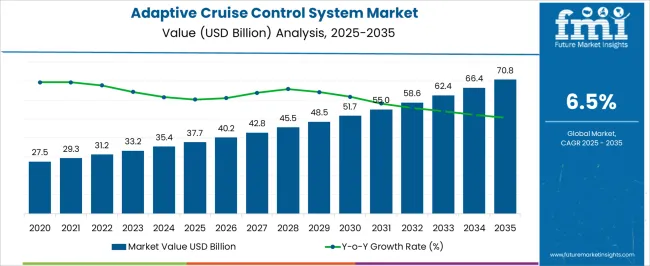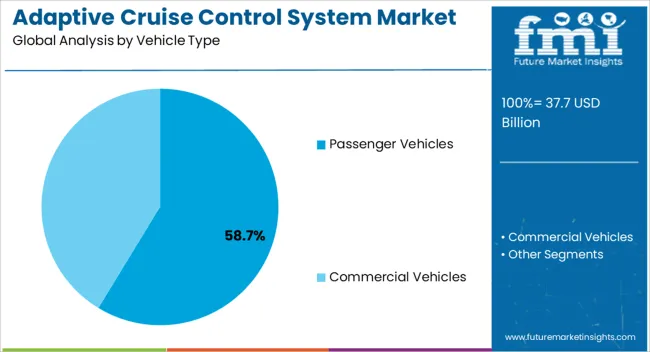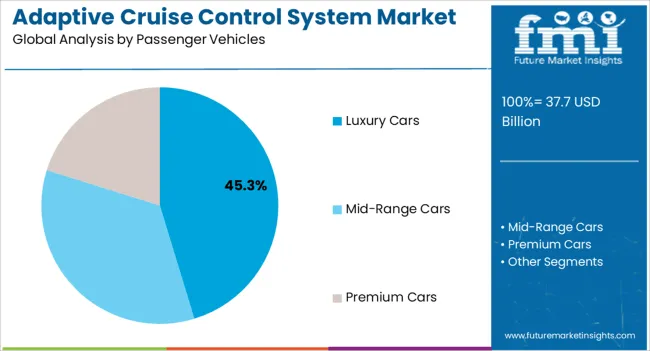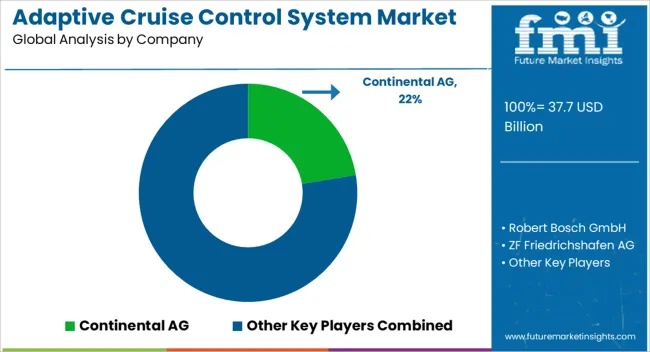The Adaptive Cruise Control System Market is estimated to be valued at USD 37.7 billion in 2025 and is projected to reach USD 70.7 billion by 2035, registering a compound annual growth rate (CAGR) of 6.5% over the forecast period.

| Metric | Value |
|---|---|
| Adaptive Cruise Control System Market Estimated Value in (2025 E) | USD 37.7 billion |
| Adaptive Cruise Control System Market Forecast Value in (2035 F) | USD 70.7 billion |
| Forecast CAGR (2025 to 2035) | 6.5% |
The adaptive cruise control system market is experiencing notable growth, supported by rising consumer preference for advanced driver assistance systems and the global push toward safer mobility solutions. Increasing regulatory emphasis on vehicle safety standards, particularly in regions with high automobile production, is accelerating adoption of these systems. Advancements in radar, lidar, and camera-based sensing technologies are enhancing system precision, making adaptive cruise control more reliable in diverse driving environments.
Automakers are increasingly integrating these systems into a wider range of vehicle models, including mid-range and entry-level segments, thereby broadening accessibility. Growing demand for comfort and convenience features in vehicles is also playing a critical role in driving market expansion.
The shift toward electrification and autonomous driving technologies is expected to further increase reliance on adaptive cruise control systems as a foundational component of future mobility platforms With heightened consumer awareness, ongoing technological improvements, and supportive regulatory frameworks, the market is positioned for consistent growth over the forecast period.
The adaptive cruise control system market is segmented by vehicle type, passenger vehicles, technology, and geographic regions. By vehicle type, adaptive cruise control system market is divided into Passenger Vehicles and Commercial Vehicles. In terms of passenger vehicles, adaptive cruise control system market is classified into Luxury Cars, Mid-Range Cars, and Premium Cars. Based on technology, adaptive cruise control system market is segmented into Radar Sensors, Infrared Sensors, Laser Sensors, Image Sensors, and Ultrasonic Sensors. Regionally, the adaptive cruise control system industry is classified into North America, Latin America, Western Europe, Eastern Europe, Balkan & Baltic Countries, Russia & Belarus, Central Asia, East Asia, South Asia & Pacific, and the Middle East & Africa.
The Asia Pacific region is projected to hold 41.2% of the adaptive cruise control system market revenue share in 2025, making it the leading regional market. This leadership is being driven by the region’s strong automotive manufacturing base, coupled with rising disposable incomes and increasing consumer demand for safety-enhanced vehicles.
Governments across major economies in Asia Pacific are promoting stricter vehicle safety regulations, encouraging manufacturers to incorporate advanced driver assistance systems as standard features. Rapid urbanization and increasing vehicle ownership are amplifying traffic congestion, creating greater demand for intelligent driving systems that improve safety and reduce driver fatigue.
The presence of leading automakers and suppliers in countries such as China, Japan, and South Korea is supporting widespread adoption, as local production enables cost efficiencies and accelerates system integration Additionally, growing interest in electric and connected vehicles across the region is creating further opportunities for adaptive cruise control integration, reinforcing Asia Pacific’s position as the dominant market.

The passenger vehicles category is anticipated to represent 58.7% of the adaptive cruise control system market revenue share in 2025, establishing itself as the dominant vehicle type. This dominance is being reinforced by the significant increase in passenger car sales worldwide, particularly in emerging economies where affordability and financing options are expanding ownership.
Consumers are placing greater emphasis on vehicle safety, comfort, and convenience features, encouraging automakers to integrate adaptive cruise control into mainstream passenger vehicles. Rising awareness of accident prevention technologies and regulatory pressure to adopt advanced driver assistance systems are further supporting the segment’s growth.
Automakers are also leveraging adaptive cruise control as a differentiating feature to enhance customer appeal and brand value, which is accelerating adoption across both compact and premium models As vehicle electrification and semi-autonomous capabilities expand, passenger vehicles are expected to remain the largest consumer segment for adaptive cruise control systems, reinforcing their central role in market growth.

The luxury cars subsegment within passenger vehicles is projected to account for 45.3% of the adaptive cruise control system market revenue share in 2025, positioning it as the leading subcategory. This dominance is being driven by the strong alignment between luxury vehicles and advanced safety, convenience, and automation technologies.
Consumers in the luxury segment demonstrate a higher willingness to pay for premium features, ensuring early adoption of adaptive cruise control as a standard offering. Luxury car manufacturers are at the forefront of incorporating the latest radar and camera technologies, enabling enhanced system performance and reliability under complex driving conditions.
The segment is also benefiting from growing sales of high-end vehicles in both developed and emerging markets, where increasing wealth levels are driving premium car purchases With luxury brands heavily investing in connected and autonomous driving technologies, adaptive cruise control is expected to remain a core component of their offerings, reinforcing this segment’s leadership in the market.
Adaptive Cruise Control (ACC) is a special form of the conventional cruise control systems which is used to maintain and control the speeds of cars and other intelligent vehicles. Adaptive cruise control is an intelligent form of cruise control systems that slows down and speeds up automatically to keep pace with the car in front of you.
It dosent make use of any satellite, any roadside infrastructures or any cooperative support from other vehicles, rather it uses sensors and lasers to control the speed of vehicles.
The main impact of adaptive cruise control system is on driver's safety as by adjusting the distance between according to the traffic conditions. The overall process is achieved through a radar headway sensor, longitudinal controller and digital signal processor.
Adaptive cruise control systems are being enhanced to guide through collision warning capabilities to warn drivers through audio or visual signals that a collision is imminent and that evasive steering is required.
Now-a-days, Adaptive cruise control system is often paired with a pre-crash system which alerts the driver and often starts braking. Adaptive cruise control is also known as autonomous cruise control, active cruise control, intelligent cruise control or radar cruise control.
The Global Adaptive Cruise Control System Market can be segmented on the basis of Geography, Vehicle Type and Technology. On the basis of Geography, the Global Adaptive Cruise Control System Market can be segmented into Asia Pacific, Europe, North America and Latin America.
On account of type, the Global Adaptive Cruise Control System Market can be segmented into passenger vehicles and commercial vehicles. Passenger vehicles include luxury cars, mid-range cars and premium cars. Further, considering technology, the Global Adaptive Cruise Control System Market can be segmented into infrared sensors, laser sensors, image sensors, radar sensors and ultrasonic sensors.
The key regions in the field of adaptive cruise control systems are Asia Pacific, Europe, Americas. The Asia Pacific region includes the emerging markets like Thailand, India and China.
The factors such as rising demands of premium and luxury cars in such regions are effective to the overall growth of the global adaptive cruise control system market.
Europe is the region which is a major market to the product and is home for the major suppliers of adaptive cruise control systems. The key regions in Europe comprises of Germany, France and Italy. The American region comprises of Brazil, Mexico, Canada and others; Brazil and Mexico being the emerging markets of this region.
The growth of the global adaptive cruise control system market highly depends on the rising number of accidents due to increase in traffic. Moreover, with the advancement of technology, people tend to be on a safer side and thus are willing to pay to install adaptive cruise control systems and thus are willing to pay.
The increasing disposable incomes and greater sales of premium and luxury cars is also a major factor driving the growth of the global adaptive cruise control system market.
The increasing use of sensors with the advancement in the technology is another fuelling factor. Moreover, government initiatives to improve fuel efficiencies and safety attributes of vehicles are motivating the manufacturers to apply such integrated systems to ensure safety as well as to comply with the government regulations.
The regions with higher intensity of fog, rainfalls and snowfalls are repelling to the adaptive cruise control systems. Regions with such weather conditions make such safety systems inefficient in making and monitoring the speeds of the surrounding objects and vehicles making the owners of the vehicles reluctant to implement such systems.
Since each and every manufacturer competes with each other, each manufacturer implements high end safety sensors thus making the car owners difficult to understand the exact operating procedures of the product.

Various companies are into manufacturing the adaptive cruise control system market. Some of the key players involved in the global adaptive cruise control system market are Denso Corporation, Magna International Inc., Mando Corporation, Valeo SA, TRW Automotive, Autoliv Inc., Hyundai Mobis Co. Ltd., Robert Bosch GmBH, Delphi Automotive PLC and others.
The research report presents a comprehensive assessment of the market and contains thoughtful insights, facts, historical data, and statistically supported and industry-validated market data.
It also contains projections using a suitable set of assumptions and methodologies. The research report provides analysis and information according to categories such as market segments, geographies, types, technology and applications.
The report is a compilation of first-hand information, qualitative and quantitative assessment by industry analysts, inputs from industry experts and industry participants across the value chain.
The report provides in-depth analysis of parent market trends, macro-economic indicators and governing factors along with market attractiveness as per segments. The report also maps the qualitative impact of various market factors on market segments and geographies.
| Country | CAGR |
|---|---|
| China | 8.8% |
| India | 8.1% |
| Germany | 7.5% |
| France | 6.8% |
| UK | 6.2% |
| USA | 5.5% |
| Brazil | 4.9% |
The Adaptive Cruise Control System Market is expected to register a CAGR of 6.5% during the forecast period, exhibiting varied country level momentum. China leads with the highest CAGR of 8.8%, followed by India at 8.1%. Developed markets such as Germany, France, and the UK continue to expand steadily, while the USA is likely to grow at consistent rates. Brazil posts the lowest CAGR at 4.9%, yet still underscores a broadly positive trajectory for the global Adaptive Cruise Control System Market. In 2024, Germany held a dominant revenue in the Western Europe market and is expected to grow with a CAGR of 7.5%. The USA Adaptive Cruise Control System Market is estimated to be valued at USD 13.2 billion in 2025 and is anticipated to reach a valuation of USD 22.6 billion by 2035. Sales are projected to rise at a CAGR of 5.5% over the forecast period between 2025 and 2035. While Japan and South Korea markets are estimated to be valued at USD 1.7 billion and USD 1.3 billion respectively in 2025.
| Item | Value |
|---|---|
| Quantitative Units | USD 37.7 Billion |
| Vehicle Type | Passenger Vehicles and Commercial Vehicles |
| Passenger Vehicles | Luxury Cars, Mid-Range Cars, and Premium Cars |
| Technology | Radar Sensors, Infrared Sensors, Laser Sensors, Image Sensors, and Ultrasonic Sensors |
| Regions Covered | North America, Europe, Asia-Pacific, Latin America, Middle East & Africa |
| Country Covered | United States, Canada, Germany, France, United Kingdom, China, Japan, India, Brazil, South Africa |
| Key Companies Profiled | Continental AG, Robert Bosch GmbH, ZF Friedrichshafen AG, Mando Corporation, Valeo, and Delphi Technologies (BorgWarner Inc.) |
The global adaptive cruise control system market is estimated to be valued at USD 37.7 billion in 2025.
The market size for the adaptive cruise control system market is projected to reach USD 70.7 billion by 2035.
The adaptive cruise control system market is expected to grow at a 6.5% CAGR between 2025 and 2035.
The key product types in adaptive cruise control system market are asia pacific, europe, north america and latin america.
In terms of vehicle type, passenger vehicles segment to command 58.7% share in the adaptive cruise control system market in 2025.






Our Research Products

The "Full Research Suite" delivers actionable market intel, deep dives on markets or technologies, so clients act faster, cut risk, and unlock growth.

The Leaderboard benchmarks and ranks top vendors, classifying them as Established Leaders, Leading Challengers, or Disruptors & Challengers.

Locates where complements amplify value and substitutes erode it, forecasting net impact by horizon

We deliver granular, decision-grade intel: market sizing, 5-year forecasts, pricing, adoption, usage, revenue, and operational KPIs—plus competitor tracking, regulation, and value chains—across 60 countries broadly.

Spot the shifts before they hit your P&L. We track inflection points, adoption curves, pricing moves, and ecosystem plays to show where demand is heading, why it is changing, and what to do next across high-growth markets and disruptive tech

Real-time reads of user behavior. We track shifting priorities, perceptions of today’s and next-gen services, and provider experience, then pace how fast tech moves from trial to adoption, blending buyer, consumer, and channel inputs with social signals (#WhySwitch, #UX).

Partner with our analyst team to build a custom report designed around your business priorities. From analysing market trends to assessing competitors or crafting bespoke datasets, we tailor insights to your needs.
Supplier Intelligence
Discovery & Profiling
Capacity & Footprint
Performance & Risk
Compliance & Governance
Commercial Readiness
Who Supplies Whom
Scorecards & Shortlists
Playbooks & Docs
Category Intelligence
Definition & Scope
Demand & Use Cases
Cost Drivers
Market Structure
Supply Chain Map
Trade & Policy
Operating Norms
Deliverables
Buyer Intelligence
Account Basics
Spend & Scope
Procurement Model
Vendor Requirements
Terms & Policies
Entry Strategy
Pain Points & Triggers
Outputs
Pricing Analysis
Benchmarks
Trends
Should-Cost
Indexation
Landed Cost
Commercial Terms
Deliverables
Brand Analysis
Positioning & Value Prop
Share & Presence
Customer Evidence
Go-to-Market
Digital & Reputation
Compliance & Trust
KPIs & Gaps
Outputs
Full Research Suite comprises of:
Market outlook & trends analysis
Interviews & case studies
Strategic recommendations
Vendor profiles & capabilities analysis
5-year forecasts
8 regions and 60+ country-level data splits
Market segment data splits
12 months of continuous data updates
DELIVERED AS:
PDF EXCEL ONLINE
Adaptive Cruise Control and Blind Spot Detection Market Analysis - Size, Share, and Forecast Outlook 2025 to 2035
Adaptive Cruise Control Market - Size, Share, and Forecast 2025 to 2035
Adaptive Access Control Market Growth – Trends & Forecast through 2034
HVAC Control System Market Size and Share Forecast Outlook 2025 to 2035
Dust Control System Market Size and Share Forecast Outlook 2025 to 2035
Noise Control System Market Analysis - Size, Share, and Demand Forecast Outlook 2025 to 2035
Odour Control System Market Growth - Trends & Forecast 2025 to 2035
Door Controller Systems Market
Version Control Systems Market Size and Share Forecast Outlook 2025 to 2035
Machine Control System Market Growth – Trends & Forecast 2025 to 2035
Charge Controller System Market Analysis - Size, Share, and Forecast Outlook 2025 to 2035
Driveline Control Systems and Devices Market Size and Share Forecast Outlook 2025 to 2035
Vibration Control Systems Market Growth - Trends & Forecast 2025 to 2035
Automated Control System Market Growth – Trends & Forecast 2024-2034
Aspiration Control Systems Market Size and Share Forecast Outlook 2025 to 2035
Hemorrhage Control System Market Size and Share Forecast Outlook 2025 to 2035
Compressor Control System Market
Command and Control System Market Size and Share Forecast Outlook 2025 to 2035
Fertigation Control System Market Size and Share Forecast Outlook 2025 to 2035
Distributed Control System Market

Thank you!
You will receive an email from our Business Development Manager. Please be sure to check your SPAM/JUNK folder too.
Chat With
MaRIA